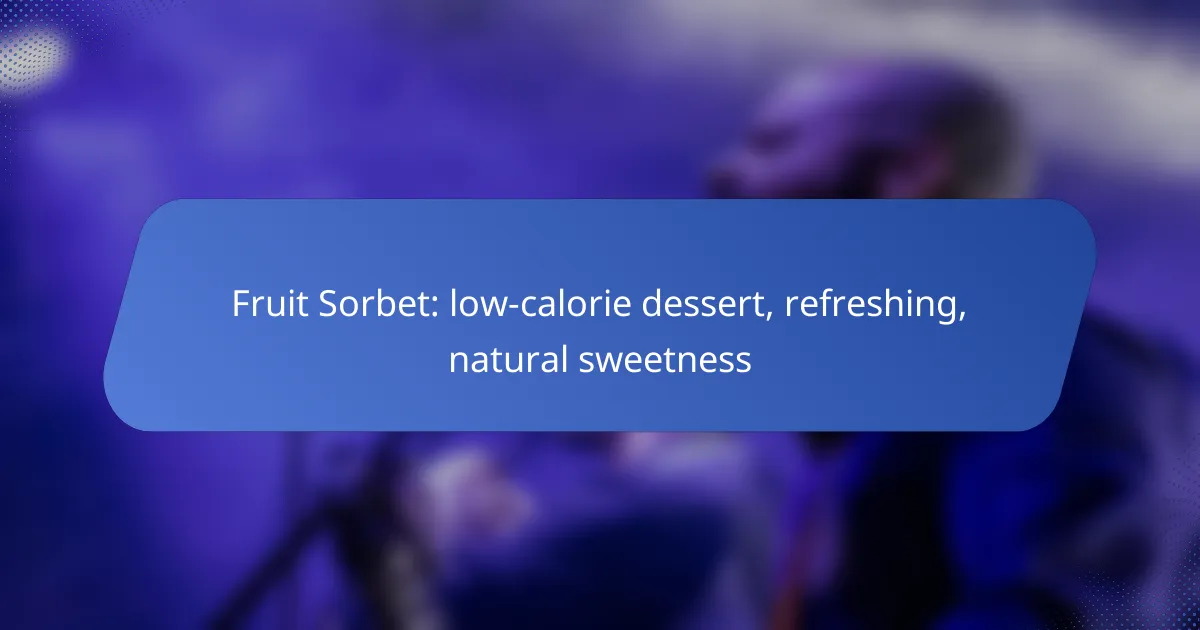Fruit sorbet is a deliciously refreshing low-calorie dessert that highlights the natural sweetness of fresh or frozen fruits. With minimal added sugars and simple preparation methods, it provides a guilt-free treat that satisfies your sweet tooth while keeping calories in check.

What are the best fruit sorbet recipes for low-calorie desserts?
Fruit sorbets are excellent low-calorie desserts that offer a refreshing taste and natural sweetness. The best recipes typically use fresh or frozen fruits, minimal added sugars, and simple preparation methods to create a delightful treat without excess calories.
Mango sorbet recipe
A mango sorbet is a tropical delight that combines ripe mangoes with a touch of lime juice. To make it, simply blend 2-3 ripe mangoes with the juice of one lime and a sweetener of your choice, if desired. Freeze the mixture for several hours until firm.
For a creamier texture, consider adding a small amount of coconut milk. This not only enhances the flavor but also keeps the calorie count relatively low while providing a rich mouthfeel.
Berry sorbet recipe
Berry sorbet can be made using a mix of strawberries, blueberries, and raspberries. Blend 2 cups of mixed berries with 1-2 tablespoons of honey or agave syrup and a splash of lemon juice. The acidity from the lemon balances the sweetness of the berries.
Freeze the mixture in a shallow dish, stirring every 30 minutes for the first couple of hours to achieve a smooth consistency. This method helps prevent ice crystals from forming, resulting in a smoother sorbet.
Pineapple sorbet recipe
Pineapple sorbet is a refreshing option that captures the essence of summer. Use 2 cups of fresh or frozen pineapple chunks, blend them with a tablespoon of lime juice, and sweeten to taste. The natural sweetness of the pineapple often means minimal added sugar is needed.
To enhance the flavor, consider adding a hint of coconut or mint. This will elevate the tropical experience while keeping the dessert light and enjoyable.
Watermelon sorbet recipe
Watermelon sorbet is incredibly hydrating and perfect for hot days. Simply blend 4 cups of seedless watermelon chunks with a tablespoon of lime juice and a sweetener if needed. The high water content of watermelon makes it a naturally low-calorie choice.
For a fun twist, mix in fresh mint leaves before freezing. This adds a refreshing note that complements the sweetness of the watermelon beautifully.
Kiwi sorbet recipe
Kiwi sorbet offers a unique tartness that many enjoy. Start with 4-5 ripe kiwis, peeled and chopped, then blend them with a tablespoon of honey and a squeeze of lemon juice. The tartness of the kiwi pairs well with a bit of sweetness.
Freeze the mixture in an airtight container, stirring occasionally to maintain a smooth texture. This sorbet not only tastes great but is also packed with vitamin C, making it a nutritious dessert option.

How can I make fruit sorbet at home?
Making fruit sorbet at home is simple and requires just a few ingredients. You can create a refreshing, low-calorie dessert using natural sweetness from fresh or frozen fruits.
Ingredients needed
To prepare fruit sorbet, you’ll need ripe fruits such as strawberries, mangoes, or peaches, along with a sweetener like honey or agave syrup. Additionally, a splash of lemon or lime juice can enhance the flavor. For a basic sorbet, aim for about 2 cups of fruit, 1/4 cup of sweetener, and 1 tablespoon of citrus juice.
Using fresh fruits will yield the best flavor, but frozen fruits can be a convenient alternative. Ensure the fruits are well-ripened for maximum sweetness and flavor.
Step-by-step preparation
Start by washing and chopping the fruits into smaller pieces. If using fresh fruit, freeze the pieces for a few hours until solid. Next, blend the frozen fruit with the sweetener and citrus juice in a food processor until smooth. Taste the mixture and adjust the sweetness if necessary.
Once blended, pour the mixture into a shallow dish and spread it evenly. This will help it freeze more quickly and evenly. Cover the dish with plastic wrap and place it in the freezer for about 2-4 hours until firm.
Freezing techniques
For optimal texture, stir the sorbet every 30 minutes during the first couple of hours of freezing. This prevents ice crystals from forming and keeps the sorbet creamy. If you prefer a softer texture, you can serve it right after blending, but it will be more like a slushy consistency.
When ready to serve, let the sorbet sit at room temperature for a few minutes to soften slightly. Use an ice cream scoop or a spoon to serve, and enjoy your homemade, low-calorie dessert!

What are the health benefits of fruit sorbet?
Fruit sorbet offers several health benefits, making it a popular choice for a refreshing dessert. It is typically low in calories, utilizes the natural sweetness of fruits, and can help with hydration.
Low-calorie content
Fruit sorbet is often lower in calories compared to traditional ice creams and desserts. A typical serving can range from 50 to 150 calories, depending on the ingredients used. This makes it an appealing option for those looking to satisfy their sweet tooth without consuming excessive calories.
When making fruit sorbet at home, consider using fresh or frozen fruits without added sugars to keep the calorie count low. Always check the nutritional information if purchasing pre-made options, as some brands may add extra sugars or fats.
Natural sweetness from fruit
The sweetness in fruit sorbet comes from the natural sugars found in fruits, such as fructose. This means you can enjoy a dessert that is not only delicious but also free from artificial sweeteners and additives. Common fruits used include strawberries, mangoes, and peaches, which provide a rich flavor profile.
Choosing ripe fruits can enhance the sweetness of your sorbet, allowing you to use less added sugar or none at all. This approach not only makes the dessert healthier but also preserves the vibrant taste of the fruits.
Hydration benefits
Fruit sorbet can contribute to hydration, especially when made with water-rich fruits like watermelon or oranges. The high water content in these fruits helps replenish fluids, making sorbet a refreshing treat during hot weather or after physical activity.
To maximize hydration benefits, consider incorporating fruits with high water content into your sorbet recipes. This not only enhances the refreshing quality but also supports overall hydration, especially in warmer climates or during summer months.

Where can I find fruit sorbet in New Zealand?
In New Zealand, fruit sorbet can be found in various locations including grocery stores, online delivery services, and specialty dessert shops. These options provide a range of flavors and brands, making it easy to enjoy this refreshing, low-calorie dessert.
Local grocery stores
Many local grocery stores across New Zealand stock fruit sorbet in their frozen dessert sections. Popular chains like Countdown and New World typically offer a selection of brands, including both local and international options. Look for sorbet made with natural ingredients for a healthier choice.
When shopping, check the labels for added sugars and artificial flavors. Many stores also have seasonal flavors, so keep an eye out for limited-time offerings that feature local fruits.
Online delivery options
Online grocery delivery services such as Foodstuffs and My Food Bag provide convenient access to fruit sorbet. You can browse various brands and flavors from the comfort of your home, often with the option for same-day delivery. This is especially useful for those who prefer to shop without visiting stores.
Be mindful of delivery fees and minimum order requirements, which can vary by service. Some platforms may also offer subscription options for regular deliveries of your favorite desserts.
Specialty dessert shops
Specialty dessert shops in New Zealand often feature artisanal fruit sorbet made from fresh, local ingredients. These shops may offer unique flavors that you won’t find in grocery stores, such as feijoa or passionfruit. Visiting these shops can be a delightful experience, as many also provide tasting samples.
Check for shops that emphasize natural sweetness and quality ingredients. Some popular options include Gelato Messina and Giapo, both known for their innovative sorbet creations. Consider calling ahead to confirm flavor availability, especially during peak seasons.

What are the differences between fruit sorbet and ice cream?
Fruit sorbet and ice cream differ primarily in their ingredients and calorie content. Sorbet is typically made from fruit puree, water, and sugar, while ice cream contains cream and milk, resulting in a richer texture and higher calorie count.
Caloric differences
Fruit sorbet is generally lower in calories compared to ice cream. A typical serving of sorbet might contain around 100-150 calories, while ice cream can range from 200-300 calories or more per serving. This makes sorbet a popular choice for those seeking a lighter dessert option.
When considering a low-calorie dessert, fruit sorbet is often a better option for those watching their caloric intake. However, it’s important to check labels, as some commercial sorbets may contain added sugars that can increase calorie counts.
Ingredient comparisons
The primary ingredients in fruit sorbet include fruit puree, water, and sugar, which contribute to its refreshing taste and lower fat content. In contrast, ice cream is made with cream, milk, sugar, and often stabilizers or emulsifiers, giving it a creamier texture and richer flavor.
Additionally, sorbet is dairy-free, making it suitable for those with lactose intolerance or dairy allergies. Ice cream, on the other hand, contains dairy, which may not be suitable for everyone. Always check ingredient lists if dietary restrictions are a concern.










